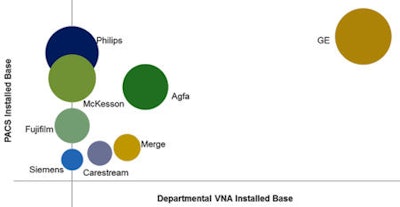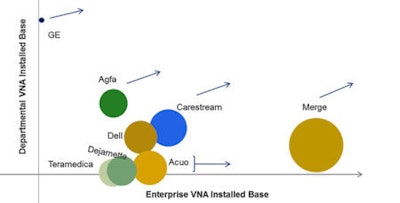
Vendor-neutral archives (VNAs) have finally moved to the forefront of healthcare IT spending, after years of debate on the value of keeping archiving separate from PACS. As demand for VNAs grows, the market is attracting a host of suppliers with a range of product types and strategies.
A challenge for traditional PACS suppliers in the VNA market is to prove their ability to deliver a nonproprietary, standards-based approach to archiving that gives healthcare providers control of their data without being locked into their PACS.
 |
| Figure 1: From PACS to departmental VNA -- North American installed base by vendor. Size of bubble represents PACS installed base in North America. All images courtesy of InMedica. |
Agfa HealthCare, Carestream Health, GE Healthcare, and Merge Healthcare have all developed VNA products, either in-house or through acquisitions. These suppliers were earlier to market with their VNA products, driving market leadership. Of these, GE has the largest share of departmental archives in North America (figure 1), while Merge, Carestream, and Agfa have established a stronger position in cross-departmental, multi-PACS enterprise archives (figure 2).
Other PACS vendors tend to partner with VNA providers: Fujifilm and Philips Healthcare have partnered with Acuo Technologies; Siemens Healthcare has partnered with Dell.
Independent software vendors
Independent software vendors (ISVs) are those who have a proprietary VNA product but not a proprietary PACS. These suppliers have emerged from outside of the PACS market to meet the challenges created by departmentalized data silos.
The leading ISVs in the VNA market are Acuo, Dell, DeJarnette Research Systems, and TeraMedica. These tend to focus on cross-departmental access to data rather than on the storage of specific departmental information.
More than 80% of VNA studies in North America in 2011 were from managing DICOM images in multiple departments or at multiple hospital sites, showing that current demand is driven by the need to consolidate images and reduce image migration costs. However, as VNA penetration increases, so, too, will demand for larger integration of non-DICOM and nonimage data.
By 2016, VNAs based on the Integrating the Healthcare Enterprise (IHE) Cross-Enterprise Document Sharing (XDS) standard are projected to account for 30% of VNA studies. VNA suppliers who currently provide full document registry and XDS repository features in their VNA are well-positioned to benefit from this shift in demand.
 |
| Figure 2: From departmental to enterprise VNA -- North American installed base by vendor. Size of bubble represents enterprise VNA installed base in North America. Arrow indicates projected direction of growth in installed base. |
Future directions
As demand for VNAs grows and healthcare providers seek better control of their data, PACS suppliers are well-positioned to increase their departmental VNA installed base by providing VNAs to their radiology PACS customers. The bigger challenge for them is to meet the needs of healthcare providers across departments.
Agfa's Impax Data Center VNA provides hospital-wide access to images and is combined with its Imaging Clinical Information System (ICIS) to integrate images into a cross-enterprise workflow to support access from the electronic health record (EHR). As such, Agfa is projected to increase its presence both in terms of departmental archives and enterprise VNA installations.
Carestream has the second largest enterprise VNA installed base in North America and also focuses heavily on cross-departmental synchronization of patient data through its Vue Connect offering. Growth in the VNA installed base is projected from Carestream's PACS installed base, from a departmental viewpoint, as well as from non-Carestream PACS customers to consolidate DICOM and non-DICOM data.
GE has the largest departmental archive installed base in North America through its Centricity Enterprise Archive. It has also recently launched Centricity Clinical Archive to provide a wider nondepartmental approach to an XDS-enabled archiving and workflow environment. Centricity Clinical Archive is classed by InMedica as VNA level 3.1 (highest possible VNA architecture) and is projected to drive GE's presence in the enterprise VNA market.
Merge has the largest VNA enterprise installed base in North America. With the introduction of the Merge Honeycomb Archive as a cloud-based platform to further enhance image sharing, Merge seeks to solidify its position as a provider of nonproprietary imaging IT platforms.
Independent VNA vendors have a greater presence in enterprise than departmental VNAs because they focus more on cross-departmental access to images and other forms of data. As VNAs are increasingly used for this purpose, they are projected to increase their presence further.
Acuo is the leading ISV in North America in terms of VNA installed base, a position it has achieved as an early entrant in the VNA market with a focus on PACS interoperability, XDS, and zero-footprint viewing. It has also successfully partnered with the largest number of third-party vendors, including Philips, EMC, and AT&T.
DeJarnette, arguably the earliest provider of interlegacy PACS integration tools, developed systems to enhance data migration and connectivity of PACS systems. Out of these, the VNA concept was formed and it has since continued to provide a standards-based approach to data storage and workflow integration across departments.
Dell, through its acquisition of InSite One, has established its unique position as the only storage provider with a proprietary VNA. Dell primarily provides a cloud-based VNA solution, which, combined with its experience in data storage, addresses the demand for reduced costs and consolidated medical data storage.
TeraMedica is also one of the earliest providers of VNAs, and its Evercore product has been deployed in departmental and enterprise models. It is, however, the cross-departmental approach to PACS data access with analytical tools that is projected to continue to drive its presence in the enterprise VNA market.
For healthcare providers, it's encouraging that VNAs are an increasing priority for PACS vendors; the strong presence of ISVs also increases the options available. As the debate swiftly moves from "whether or not to adopt a VNA" to "which VNA to adopt," it's up to vendors to prove their ability to meet the most important VNA adoption criteria: reduced storage costs, reduced migration costs, enhanced image sharing, synchronized cross-departmental workflow, enhanced business continuity, and enhanced nonimage data sharing.
Theo Ahadome is lead market analyst for healthcare IT at InMedica, the medical research division of IMS Research. The information in this article is obtained from InMedica's research on healthcare IT markets, including PACS, RIS, cardiovascular information systems, enterprise management, cloud storage, and vendor-neutral archives. He can be reached at [email protected].
The comments and observations expressed herein do not necessarily reflect the opinions of AuntMinnie.com, nor should they be construed as an endorsement or admonishment of any particular vendor, analyst, industry consultant, or consulting group.



















